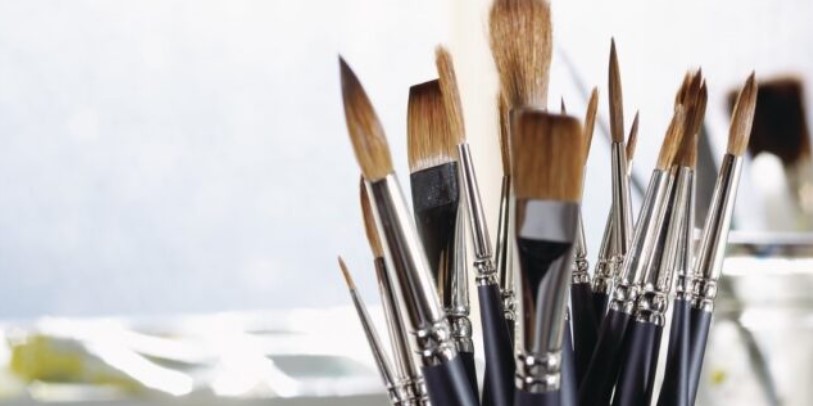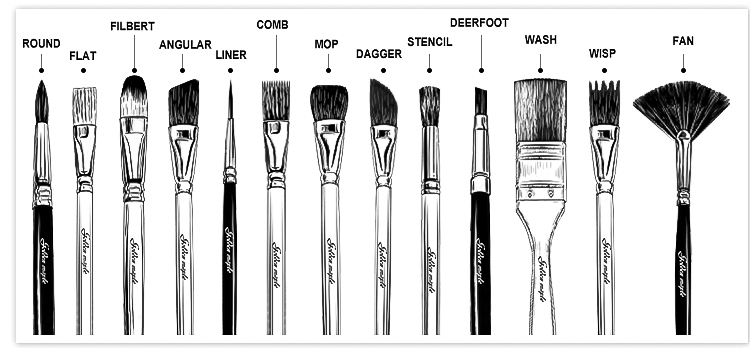Walking into any artist’s store, the number of brushes on display at the beginning seems irresistible. Should you choose natural fiber or synthetic fiber? Which head type is most suitable? Is it best to go to the most expensive one? Don’t be afraid: by exploring these issues more, you can narrow the number of choices you need to make and find the right tools for the job.
Hairstyle
Different Media, Such As Watercolor, Acrylic or Traditional Oil, Require Different Types of Brushes. There Are Four Main Types:
Natural Hair
Pig Hair (bristle)
Synthetic Hair
Hybrid (synthetic and Natural)
Natural hair
Natural hair brushes are a good choice for watercolor or gouache paintings because they are softer and more flexible than pig hair brushes. There are different types of natural hairbrushes.
Sable brushes maintain perfect spots, can be controlled well, and are very suitable for precise marking. Mink hair is also naturally absorbent, which means that these brushes can retain a lot of color for excellent flowability. Sable brushes are of very high quality, and the best-such as Winsor & Newton Series 7 brushes-are handmade from the tip of a Siberian kolinsky sable.
The color of the squirrel brush is very good because they can hold a lot of water. They are very suitable for use as mops and scrubbing because they are not as pointed as sables.
Goat brushes also have good color bearing capacity, but they often do not release color like squirrels or sables, and are meaningless.
Camel is a term used for a series of miscellaneous low-quality natural brushes.
One exception that can effectively use natural bristle brushes with thicker media is the pony brush. The pony brush has coarse hair, does not form a tip, and has almost no springs. When oils or acrylics are used, their stiffness is useful.
Pig Hair (bristle)
If You Use Oil or Acrylic Resin, a Natural Pig Hair Brush is a Good Choice. They Are Naturally Hard, and Each Bristles is Divided into Two or Three at the Tip. These Splits Are Called Signs, and They Allow the Brush to Hold More Paint and Apply Evenly. Remember That Pig Brushes Come in Different Shades; if They Are White, You Need to Make Sure They Are Natural and Not Bleached, Which Will Weaken the Bristles. Pig Hair Has Different Qualities.
Best Hog Has the Hardest Hair, a Lot of Flags, Can Be Dyed More Colors, and is Very Flexible-so the Brush Can Maintain Its Working Edge and Shape for Longer. Winsor & Newton Artists’ Pig Brushes Are Made from the Best Quality Pigs.
the Better Pigs Have a Slightly Softer Hair Than the Best Pigs, and They Will Not Wear Out.
Good Pigs Are Softer. This Type of Brush Cannot Maintain Its Shape Well.
Poor Quality Pigs Are Soft, Weak and Easy to Open, Which Makes Color Control Difficult.
Synthetic
If You Prefer Alternatives to Natural Hair or Have a Limited Budget, then It is Worth Considering Using a Synthetic Brush. Driven by Innovation and Our Unique Brush Making Expertise, Our Synthetic Brushes Are Professional. They Can Be Soft or Hard; Soft-bristled Brushes Are Suitable for Watercolors, While Hard-bristled Brushes Are Suitable for Oils. Synthetic Brushes Usually Have a Good Point and Can Carry Color Well. Winsor & Newton Offers a Wide Range of Synthetic Brushes, Including Monarch Brushes, Cotman Brushes and Galeria Brushes.
Winsor & Newton Has Launched Two New Synthetic Brush Series: Professional Watercolor Synthetic Sable Brush and Artist Oily Synthetic Pig Brush. After Rigorous Artist Testing, We Have Developed an Innovative Synthetic Bristle Blend That Provides the Quality and Performance You Usually See in Natural Sable and Bristles Brushes.
The Professional Watercolor Synthetic Sable Brush Has Excellent Color Bearing Capacity, Can Make Various Marks and Elastic Springs and Shape Retention.
Artists’ Oil Synthetic Hog is Made of Marked Bristles, Replicating the Marks of Natural Pig Hair Bristles, Maintaining Shape, Strong Bristles and Excellent Color Carrying Capacity.
Both Series Are 100% Fsc ® Certified; the Birch Used for the Unique and Stylish Ergonomic Handle is Derived from Sustainable Sources, and the Development of Responsible Forest Management is Constantly Being Considered.
Blends
Sable and Synthetic Blends Such As Sceptre Gold Ii Provide a Performance That is Close to Sable at a Price That is Close to Synthetic.
Brushes Come in Different Sizes and These Sizes Are Given Numbers. However, Each Number Does Not Necessarily Equate to the Same Size Brush in Different Ranges, and This is Particularly Noticeable Between English, French and Japanese Sizes. Consequently, if You Are Choosing a Brush It is Important That Actual Brushes Are Compared Rather Than Simply Relying on the Sizes of the Brushes You Currently Own.
Handle Length Varies As Well. if You Are Working in Oil, Alkyd or Acrylic You May Often Find Yourself Painting at a Distance from Your Surface, So a Long-handled Brush Would Be Best. if You Are a Watercolourist then It is Likely You Will Work Closer to Your Painting, Making a Shorter Handle a Good Investment.
Different Brushes Come in Different Shapes. Natural Sable Brushes Are Generally Round, but They Do Come in Different Sizes. However, Hog Brushes and Other Bristle Brushes Are Offered in a Range of Shapes, As Well As Sizes, Allowing Different Types of Marks to Be Made. Shapes Include Round, Long Flat, Filbert, Short Filbert, Short Flat/bright, and Fan.
Cost
When it comes to brushes, you tend to get what you pay for, so buying the best quality brushes for your work will always be the preferred option. Poor quality brushes may not perform well. For example, a poor quality hog hair artist brush will splay and soften, making messy marks and hindering the control of the colour. Cheap, softer synthetic brushes will hold little colour and may not keep their point. Poor quality brushes will also deteriorate quickly, and you may find yourself spending more money on two or three cheap brushes than on one high quality brush that lasts for years.
Caring for your brushes
Taking good care of your brushes will extend their lifespan and mean you can work with tried and tested tools year after year. Take a look at our guide to caring for and cleaning brushes for more information.
Post time: Nov-19-2021






